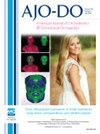评估使用隐形牙对准治疗的下颌前磨牙拔牙位置附近牙齿计划和实现的牙根角度变化:一项回顾性研究。
IF 3
2区 医学
Q1 DENTISTRY, ORAL SURGERY & MEDICINE
American Journal of Orthodontics and Dentofacial Orthopedics
Pub Date : 2025-06-01
DOI:10.1016/j.ajodo.2025.01.011
引用次数: 0
摘要
简介:本研究旨在确定Invisalign (Align Technology, Santa Clara, california)在实现臼齿、前磨牙和下颌前磨牙拔牙位置附近犬的计划牙根成角方面的功效。方法:将2013年至2019年间使用Invisalign矫正器并拔出至少1颗下颌第一(L4)或第二(L5)前磨牙的成年患者的数字模型导入Geomagic Control X (3D Systems, Rock Hill, SC)计量平台后进行评估。结果:31例患者,包括30例L4和25例L5拔除。规划的根角变化精度范围为-119.05% ~ 162.75%。在L4和L5提取部位观察到相似的表达模式。当根向拔牙位置倾斜时,在犬齿和第一磨牙中可能会出现根运动的过度表达。计划的根角变化可能在L4附近的前磨牙中低表达,而在L5附近的前磨牙中高表达更为常见。根成角结果与患者性别、处方矫正器数量或附着体类型无关(P < 0.05)。2周的磨损方案与1周的磨损方案相比(P = 0.005),当冠从L5拔牙位置倾斜时,根角度明显减少4.52°。结论:下颌前磨牙拔牙部位牙根角度变化与原计划不一致。与传统的附着体相比,使用优化的附着体似乎不能改善根成角的结果。本文章由计算机程序翻译,如有差异,请以英文原文为准。
Evaluation of planned and achieved root angulation changes in teeth adjacent to mandibular premolar extraction sites in patients treated with Invisalign: A retrospective study
Introduction
This study aimed to determine the efficacy of Invisalign (Align Technology, Santa Clara, Calif) in achieving planned root angulation of molars, premolars, and canines adjacent to mandibular premolar extraction sites.
Methods
Digital models of adult patients treated with Invisalign aligners and extraction of at least 1 mandibular first (L4) or second (L5) premolar between 2013 and 2019 were evaluated after import into the Geomagic Control X (3D Systems, Rock Hill, SC) metrology platform.
Results
Thirty-one patients, comprising 30 L4 and 25 L5 extractions, were assessed. The accuracy of the planned root angular changes ranged from −119.05% to 162.75%. Similar patterns of expression were observed across the L4 and L5 extraction sites. When root tipping away from the extraction site was planned, the overexpression of root movement was likely in the canines and first molars. Underexpression of planned root angulation change was likely in the premolar adjacent to the L4 extraction site, whereas overexpression was more common in a premolar adjacent to a L5 extraction site. No differences in root angulation outcomes related to patient sex, number of prescribed aligners, or attachment type (P >0.05) were observed. A 2-week wear protocol resulted in a significant (P = 0.005) shortfall of 4.52° of root angulation compared with the 1-week wear protocol when crown tipping away from the L5 extraction sites was planned.
Conclusions
The root angulation changes in teeth near the mandibular premolar extraction sites did not match those planned. The use of optimized attachments appeared not to improve root angulation outcomes compared with conventional attachments.
求助全文
通过发布文献求助,成功后即可免费获取论文全文。
去求助
来源期刊
CiteScore
4.80
自引率
13.30%
发文量
432
审稿时长
66 days
期刊介绍:
Published for more than 100 years, the American Journal of Orthodontics and Dentofacial Orthopedics remains the leading orthodontic resource. It is the official publication of the American Association of Orthodontists, its constituent societies, the American Board of Orthodontics, and the College of Diplomates of the American Board of Orthodontics. Each month its readers have access to original peer-reviewed articles that examine all phases of orthodontic treatment. Illustrated throughout, the publication includes tables, color photographs, and statistical data. Coverage includes successful diagnostic procedures, imaging techniques, bracket and archwire materials, extraction and impaction concerns, orthognathic surgery, TMJ disorders, removable appliances, and adult therapy.

 求助内容:
求助内容: 应助结果提醒方式:
应助结果提醒方式:


